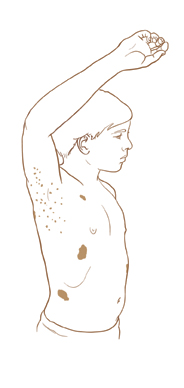When Your Child Has Neurofibromatosis Type 1 (NF1)
Neurofibromatosis type 1 (NF1) is a condition that causes the abnormal growth of pigment cells in the skin. It also causes noncancerous (benign) tumors along nerves in the skin, brain, and other parts of the body. NF1 is often not life-threatening. But other problems may occur over time. These may include seizures, developmental delay, and increased risk for cancerous and noncancerous tumors. Your child’s healthcare provider will tell you more about your child’s condition and treatment choices.
What causes NF1?
NF1 is caused by a change (mutation) in genes that affect nerve growth. This change may happen for unknown reasons. Or it may be passed down in families (inherited). If a diagnosis is confirmed, parents and siblings should be checked for the condition as well.
What are the symptoms of NF1?
 |
| With NF1, your child may have cafe-au-lait marks on the skin in areas such as the chest or underarms. |
Symptoms for NF1 include:
-
Skin lesions. These can include light-brown spots or freckles in the underarms and groin. The light-brown spots are called café-au-lait spots. These skin lesions are not harmful. But they may make a child feel self-conscious.
-
Lisch nodules. These are lesions on the colored part of the eye (the iris). They may be found during a routine eye exam.
-
Tumors. These can grow on or under the skin. They can also form along certain nerves, especially the optic (eye) nerve or spinal nerves. Tumors can also form in the brain and other body areas. The tumors are often not cancer. But tumors that grow in certain parts of the body can cause serious problems that need treatment.
-
Problems with bone growth. This can happen especially along the spine. This may cause scoliosis.
-
Nervous system problems. These may include headaches or seizures. A child may also have developmental delay. This may include problems with learning, reasoning, or behavior.
-
Thinking and behavioral problems. Many children with NF1 can have trouble adjusting at school. This may cause them to feel depressed and parents to worry. These issues need to be recognized early on and addressed correctly.
How is NF1 diagnosed?
Many symptoms are not present in the early years, but will occur by age 10. It often takes several years to make the diagnosis of NF1. Your child will likely see a pediatric neurologist for diagnosis and treatment. This is a healthcare provider who treats nervous system problems. They will ask about your child’s health history. This is to learn more about your child’s symptoms, other health problems, and family health history. Your child may also have tests, such as:
-
Nervous system exam. This is to check how well your child’s nervous system is working. During the exam, the healthcare provider checks your child’s muscle strength, balance, coordination, and reflexes. They also check skills such as memory, vision, hearing, talking, and swallowing.
-
Skin exam. This is to check for NF1 skin lesions or tumors.
-
Imaging tests. These are to check for tumors and see where they are growing.
-
Genetic tests. These are to check for the mutation.
To diagnose NF1, a healthcare provider looks for two or more of the below:
-
Six or more light brown spots on the skin (café-au-lait spots), measuring more than 5 mm (millimeters) across in younger children or more than 15 mm across in older children
-
Two or more neurofibromas, or one neurofibroma that affects many nerves (plexiform neurofibroma)
-
Freckles in the armpit or the groin
-
Two or more growths on the eye's iris (called Lisch nodules or iris hamartomas)
-
A tumor on the optic nerve (optic nerve glioma)
-
Abnormal development of the spine (scoliosis), the temple (sphenoid) bone of the skull, or one of the long bones of the shin called the tibia
-
A parent or sibling with NF1
How is NF1 treated?
Treatment for NF1 depends on your child’s needs. Treatment may include:
-
Surgery. This may be done to remove any tumors or correct any skin lesions.
-
Medicines. These can help control other health problems, such as headaches or seizures.
-
Special educational services. These can help with any learning problems.
-
Supportive care. This may include speech, physical, or occupational therapy.
What are the long-term concerns?
NF1 is a lifelong condition. But your child can learn ways to manage symptoms and be as active and independent as possible. Regular visits to the healthcare provider are advised to check your child’s health and to do routine testing. In rare cases, tumors become cancer (malignant). If this happens, your child may need other treatments, such as chemotherapy or radiation.
Support and resources
A positive outlook helps while supporting your child. Encourage your child to be active and to try new things. Think about talk therapy (counseling), which can help you and your child deal with any worries or concerns. And get help from your friends, community resources, and support groups. The more you learn about your child’s condition and its treatments, the more in control you may feel. For more information about neurofibromatosis, contact the following organizations:
Online Medical Reviewer:
Dan Brennan MD
Online Medical Reviewer:
Joseph Campellone MD
Online Medical Reviewer:
Raymond Kent Turley BSN MSN RN
Date Last Reviewed:
12/1/2022
© 2000-2024 The StayWell Company, LLC. All rights reserved. This information is not intended as a substitute for professional medical care. Always follow your healthcare professional's instructions.